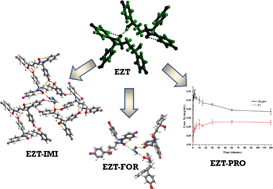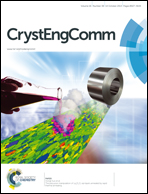New cocrystals of ezetimibe with l-proline and imidazole†
Abstract
The objectives of the study were to screen and prepare cocrystals of anti-cholesterol drug ezetimibe (EZT) with the aim of increasing its solubility and dissolution rate. Thermodynamic phase diagram based high throughput screening was performed using wet milling/grinding or solution crystallization methods. A large number of coformers were tested and the resulting solids were preliminarily characterized using X-ray powder diffraction (PXRD) and Raman spectroscopy. Potential cocrystals of EZT with L-proline and imidazole and a solvate formamide were identified in the screening experiments. The cocrystal hits were further characterized by differential scanning calorimetry (DSC), thermogravimetric analysis (TGA), solution Proton nuclear magnetic resonance spectroscopy (1H-NMR) and single crystal XRD. The dissolution properties and stability of cocrystals were determined. Single-crystal X-ray diffraction data were obtained for EZT, EZT-IMI cocrystal and formamide solvate of ezetimibe. All three systems were crystallized in non-centrosymmetric orthorhombic space group P212121 with Z = 4. Robust O–H⋯O, O–H⋯N, N–H⋯O and C–H⋯O hydrogen bonds played an important role in all these crystal structures. EZT-PRO cocrystal showed improved apparent solubility and solid state stability.


 Please wait while we load your content...
Please wait while we load your content...